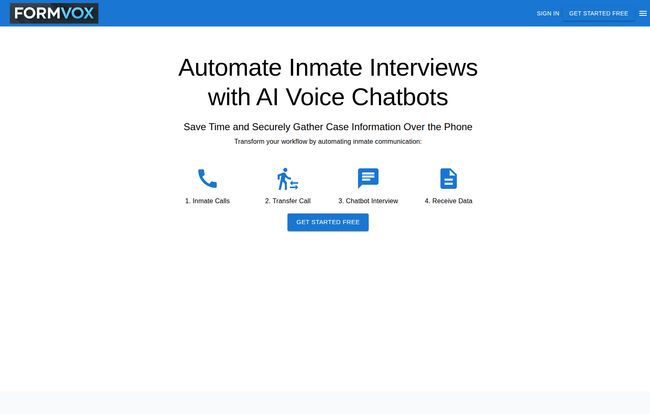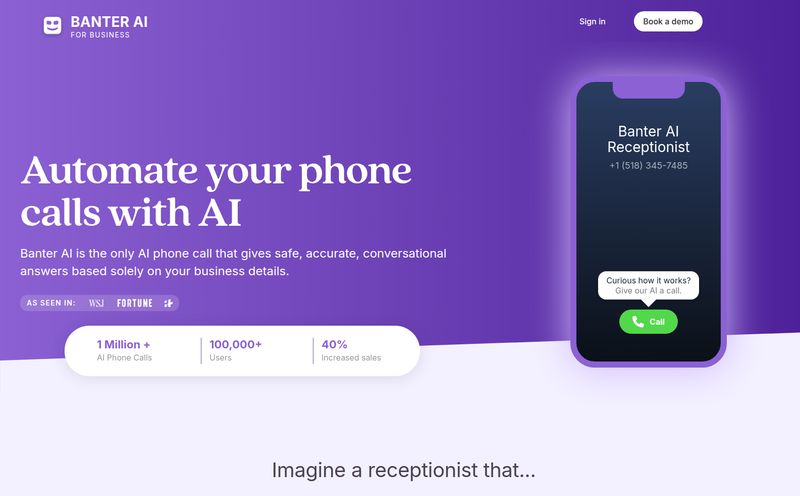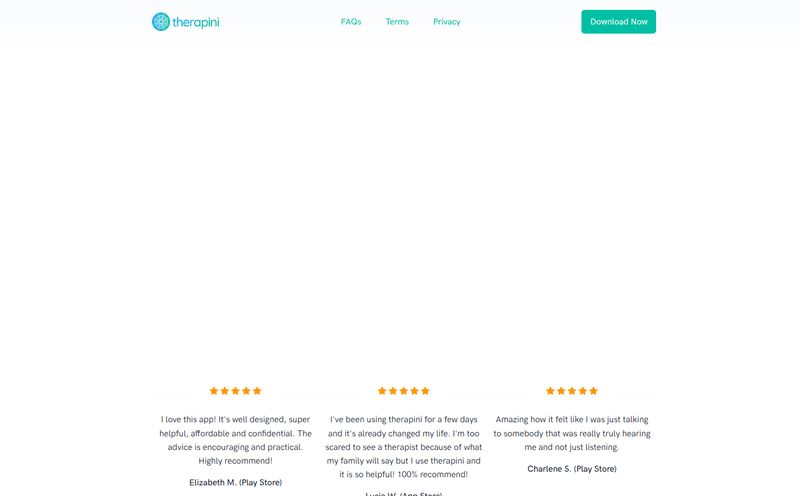Nobody likes filling out forms. As a business owner, you hate chasing people to fill them out. As a customer, you hate the tiny boxes, the endless questions, the inevitable “password must contain a capital letter, a number, a hieroglyph, and the blood of a unicorn.” It's a point of friction we’ve all just sort of... accepted. A necessary evil in the world of data collection and lead generation.
For years, we in the SEO and traffic world have obsessed over optimizing on-page forms. Reducing fields, improving UX, A/B testing button colors. But what if the form wasn't on a page at all? What if you could just… talk to it?
That’s the premise behind a tool I’ve been tinkering with called FormVox. It popped up on my radar recently, and the concept was so simple, so wildly different from the usual web-based solutions, that I had to take a look. It’s a platform that automates intake and surveys using a voice chatbot over the phone. Yeah, you read that right. People call a number and just speak their answers. Wild.
So, What Exactly is FormVox?
Think of FormVox as a tireless digital receptionist whose only job is to conduct interviews. It doesn’t need a lunch break, it never gets grumpy, and it can handle a dozen calls at once. The core idea is to replace paper or web forms with a guided phone conversation, powered by AI.
Someone—a potential client, a job applicant, a survey respondent—dials a number or gets transferred to the FormVox system. From there, a voice chatbot takes over, asking a series of pre-programmed questions. The person on the other end just talks, and the system captures their answers, organizes the data, and sends it right back to you. No typing, no clicking, no squinting at a tiny screen.
It’s a fascinating application of voice AI that sidesteps the whole visual interface problem completely.
The Big "Why?" - Who is This For?
My first thought was, “Okay, but who really needs this?” The website’s primary example immediately answered my question: legal practices. Specifically, those handling inmate case evaluations. And suddenly, it all clicked.
Imagine the logistics there. Your potential client doesn't have internet access. They have limited and often monitored time on the phone. Sending and receiving paperwork is a slow, painful process. Having a paralegal spend hours on the phone just for an initial screening is a huge drain on billable hours. FormVox offers a direct line. The inmate calls, a bot handles the initial 5-10 minute screening, and the law firm gets a clean, transcribed set of data to decide if the case is a good fit. That’s not a gimmick; thats a serious operational improvement.
But my mind started racing. What about other fields?
- Healthcare: Pre-registering new patients over the phone, especially for older demographics who might not be comfortable with online patient portals.
- High-Volume Recruiting: Running initial screenings for hourly jobs. “Are you over 18? Do you have a valid driver’s license? Can you work weekends?” Boom, done.
- Market Research: Reaching demographics that aren’t chronically online. A simple phone survey can feel more personal and accessible than an email link that gets buried in a spam folder.
- Field Services: A technician could call in and log a service report just by talking, instead of fumbling with a tablet with greasy hands.
The common thread here is accessibility and efficiency. It's for any situation where a web form is impractical or a human-to-human call is inefficient for a simple, repetitive task.
How FormVox Actually Works (The Nuts and Bolts)
From what I've gathered, the setup seems pretty straightforward. You design your questionnaire on the FormVox platform. This is where the magic really happens. You're not just listing questions; you’re building a conversation. The platform boasts about its “Rules-Based Chatbot Conversations,” and the key feature here is conditional logic.
If you’re not a tech person, conditional logic is just a fancy way of saying “if-then.” For example:
Bot: “Are you seeking representation for a new case?”
Caller: “Yes.”
Bot: “Great. What type of case is it? Criminal, civil, or family law?”
But if the caller said “No,” the conditional logic would redirect them down a different path entirely.
Bot: “Are you seeking representation for a new case?”
Caller: “No.”
Bot: “Okay, are you calling for an update on an existing case?”
This makes the conversation feel more natural and dynamic, preventing people from having to answer irrelevant questions. You build out this conversational tree, and the AI handles the rest. Once the call is done, the data appears in your dashboard, all neat and tidy.

Visit FormVox
The Good, The Bad, and The Bot-Voiced
No tool is perfect, right? Here’s my breakdown of what gets me excited and what gives me pause.
What I Really Like About FormVox
The time-saving is the most obvious win. The cost of one hour of your intake specialist’s time is almost certainly more than the $10 for an hour of chatbot time. It lets your skilled human staff focus on the high-value parts of their job—like building rapport with qualified leads—instead of the robotic task of asking the same ten questions over and over.
But for me, the accessibility angle is huge. We forget that not everyone lives on a stable Wi-Fi connection with the latest smartphone. For certain populations, a phone call is the most reliable form of communication. Building a service around that reality is, frankly, brilliant. It’s a reminder that good tech meets people where they are, instead of forcing them to come to you.
Some Lingering Questions and Potential Hiccups
Okay, let’s talk about the elephant in the room: voice recognition. We’ve all been there, shouting “No, I said PLAY KANSAS!” at our smart speaker while it confidently plays the latest from Arkansas. Voice recognition has gotten amazingly good, but it's not foolproof. Heavy accents, background noise, mumbled speech… these are all potential points of failure. I would want to do some serious testing before rolling this out to all my clients.
Then there’s the human element. Or the lack thereof. An experienced paralegal can pick up on tone of voice, hesitation, or urgency in ways a bot simply can’t. For a straight data-gathering mission, that’s fine. But for a sensitive intake process, you might lose some valuable nuance. Some might argue that for initial screening, you want to remove emotional bias, and that's a fair point. It’s a tradeoff you have to be comfortable with.
Let's Talk Money: The FormVox Pricing Structure
This is often the make-or-break part for any new software, and I have to say, FormVox’s approach is refreshing. They have a very straightforward, two-tiered system.
| Plan | Cost | Key Feature |
|---|---|---|
| Pay-as-you-go | $10 / hour of Voice Chatbot Talk Time | No subscription. Perfect for low volume or testing. |
| Enterprise | $599 / month | Includes 100 hours of talk time, plus personalized setup. |
I absolutely love the Pay-as-you-go option. The biggest barrier to trying new SaaS tools is the dreaded monthly subscription for something you might not even use. At $10 an hour, you can genuinely try this out, run a pilot program, and see if it works for you with minimal financial risk. More companies should do this.
The Enterprise plan is clearly for the big players—the high-volume law firms or call centers who can easily see the ROI on offloading 100+ hours of intake calls from their human staff.
My Final Take: Is FormVox a Gimmick or a Game-Changer?
So, what’s the verdict? It’s not a gimmick. Not at all.
FormVox isn't trying to be a Swiss Army knife that solves every data collection problem. It's more like a specialized torque wrench designed for a very specific, and often very tight, bolt. It won't replace your website's contact form or your complex multi-page surveys. But for phone-based intake and screening? It’s a remarkably clever solution to a very real problem.
It’s a tool that understands its niche and serves it well. In a world cluttered with do-everything platforms, that kind of focus is something I can really get behind. It’s a smart application of technology that could genuinely make a difference in the day-to-day operations of the right kind of business.
Frequently Asked Questions about FormVox
- How does the data collected stay secure?
- The website mentions that the data collection is secure and compliant with legal standards. For specific industries like law or healthcare dealing with sensitive information, this is critical, and it would be wise to confirm their specific compliance (like HIPAA) directly with them.
- Do callers need any special app or software?
- Nope. And that’s the beauty of it. All they need is a phone. The entire process happens over a standard phone call, making it incredibly accessible.
- How well does the chatbot handle different accents or background noise?
- This is the million-dollar question for any voice AI. While modern systems are quite advanced, performance will always depend on factors like the clarity of the phone connection and the speaker's diction. The best approach would be to run a few test calls yourself to gauge its accuracy before going live.
- Can I customize the chatbot's voice and greeting?
- The platform allows for professionally scripted voice prompts. This implies a good degree of customization to ensure the bot sounds professional and aligns with your brand's tone. You can likely record your own greetings or use high-quality text-to-speech voices.
- Is there a free trial to test it out?
- While there isn't a formal “free trial” mentioned, the Pay-as-you-go plan at $10/hour is essentially a low-cost, low-risk way to trial the service. You only pay for what you actually use, which is even better in some ways.
- What happens if a caller needs to speak to a real person?
- A well-designed conversational flow should include an option for this. For example, you could program the bot to say, “If you would prefer to speak with a member of our team, please press 1 now,” and then have the system transfer the call to a human.
Conclusion
FormVox is a powerful reminder that sometimes the best solution isn’t about adding more tech, but about applying it in a smarter, more focused way. By taking the friction-filled process of form-filling and moving it to the simple, universal interface of a phone call, they've created something genuinely useful. It's not for everyone, and it's not for every situation. But for businesses that rely on phone-based intake, it has the potential to be a massive time-saver and efficiency booster. The future of user interaction is becoming more conversational, and FormVox is a very cool, very practical peek at what that future looks like.
Reference and Sources
- FormVox Official Website
- FormVox Pricing Page
- Baymard Institute - Cart Abandonment Rate Statistics (A great resource on user friction in online forms)



